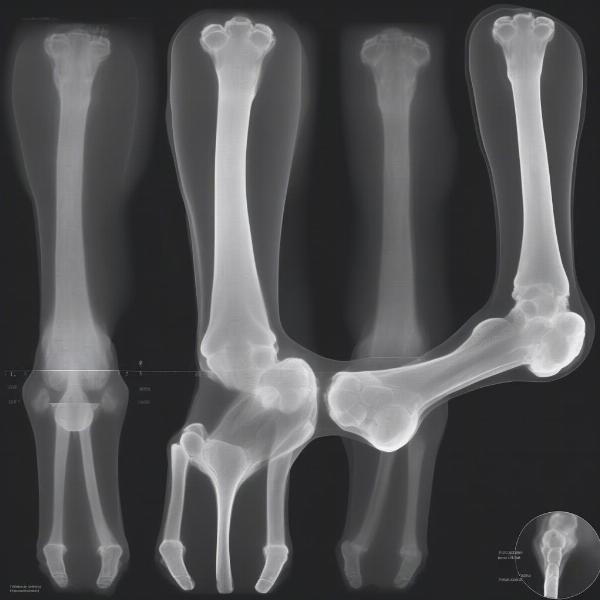Bone diseases in young dogs can be a serious concern for pet owners. These conditions can cause pain, lameness, and even developmental problems. Understanding the common types of bone diseases, their symptoms, and treatment options is crucial for ensuring your puppy grows into a healthy adult. This article will explore the prevalent bone diseases affecting young dogs, providing you with valuable insights to help you recognize and address these issues effectively.
Understanding Common Bone Diseases in Puppies
Several bone diseases can affect growing puppies. These conditions often result from genetic predisposition, nutritional deficiencies, or trauma. Early diagnosis and intervention are critical for managing these diseases and minimizing long-term consequences. Let’s delve into some of the most common bone diseases affecting young dogs.
Osteochondrosis (OCD)
OCD is a developmental orthopedic disease that affects the cartilage and bone in the joints of rapidly growing large and giant breed puppies. It occurs when the cartilage doesn’t form properly, leading to cracks, flaps, or even complete separation of the cartilage from the underlying bone. This can cause pain, lameness, and joint instability.
Hypertrophic Osteodystrophy (HOD)
HOD is a painful inflammatory bone disease that typically affects young, rapidly growing large and giant breed dogs. Symptoms include lameness, swelling around the joints, fever, and decreased appetite. The exact cause of HOD is unknown, but it’s thought to be related to abnormal bone development.
Panosteitis
Panosteitis, often referred to as “growing pains,” is a self-limiting condition characterized by inflammation of the long bones in young, large breed dogs. Symptoms include shifting leg lameness, pain on palpation of the affected bone, and sometimes fever and loss of appetite.
 Panosteitis in Young Dogs
Panosteitis in Young Dogs
Legg-Calvé-Perthes Disease
Legg-Calvé-Perthes disease affects the hip joint, specifically the femoral head (the ball of the hip joint). It involves the disruption of blood supply to the femoral head, leading to bone necrosis (death of bone tissue). This condition primarily affects small and toy breed dogs.
Diagnosing and Treating Bone Diseases
Diagnosing bone diseases in young dogs typically involves a combination of physical examination, radiographs (x-rays), and sometimes other imaging techniques like CT scans or MRI. Treatment varies depending on the specific disease, its severity, and the age and overall health of the dog.
Treatment Options
Treatment options for bone diseases in young dogs may include:
- Medication: Pain relievers, anti-inflammatories, and other medications can help manage pain and inflammation.
- Surgery: In some cases, surgery may be necessary to correct deformities, remove damaged cartilage or bone, or stabilize the joint.
- Physical therapy: Physical therapy can help improve joint function, range of motion, and muscle strength.
- Nutritional management: Ensuring a balanced diet with appropriate levels of calcium, phosphorus, and other essential nutrients is vital for healthy bone development.
Preventing Bone Diseases in Puppies
While not all bone diseases are preventable, some measures can help reduce the risk:
- Choose a reputable breeder: Reputable breeders screen their dogs for genetic predispositions to certain bone diseases.
- Provide a balanced diet: Feeding a high-quality diet formulated for growing puppies is essential for proper bone development.
- Avoid over-supplementation: Over-supplementation of vitamins and minerals, especially calcium, can be detrimental to bone health.
- Control growth rate: Rapid growth, particularly in large and giant breeds, can increase the risk of certain bone diseases. Consult your veterinarian about appropriate feeding strategies to manage growth rate.
Conclusion
Bone diseases in young dogs can be concerning, but with early diagnosis and appropriate management, many puppies can live happy and healthy lives. Understanding the common types of bone diseases, their symptoms, and treatment options is crucial for responsible pet ownership. If you suspect your puppy has a bone disease, consult your veterinarian immediately for a proper diagnosis and treatment plan.
FAQ
- What are the first signs of bone disease in a puppy? Lameness, swelling around the joints, pain, and reluctance to exercise are common early signs.
- Are certain breeds more prone to bone diseases? Yes, large and giant breeds are often predisposed to conditions like OCD, HOD, and panosteitis, while small breeds are more susceptible to Legg-Calvé-Perthes disease.
- Can bone diseases in puppies be cured? The outcome depends on the specific disease and its severity. Some conditions can be managed effectively with medication and lifestyle modifications, while others may require surgery.
- How can I prevent bone diseases in my puppy? Choosing a reputable breeder, providing a balanced diet, controlling growth rate, and avoiding over-supplementation can help reduce the risk.
- What should I do if I suspect my puppy has a bone disease? Consult your veterinarian immediately for a proper diagnosis and treatment plan.
Related Articles
About ILM Dog
ILM Dog is your trusted international resource for comprehensive dog care and breed information. We provide expert guidance on various aspects of dog ownership, including breed selection, health and medical care, training, nutrition, grooming, and much more. We are dedicated to helping you navigate the joys and challenges of raising a happy and healthy canine companion. For expert advice and personalized support, contact us at [email protected] or call +44 20-3965-8624. Visit ILM Dog for more information.